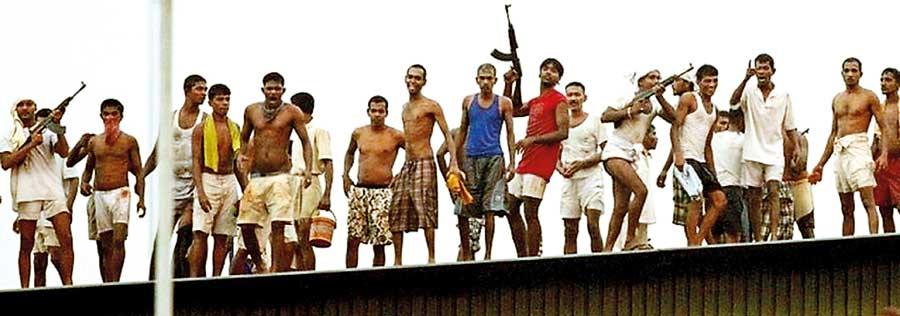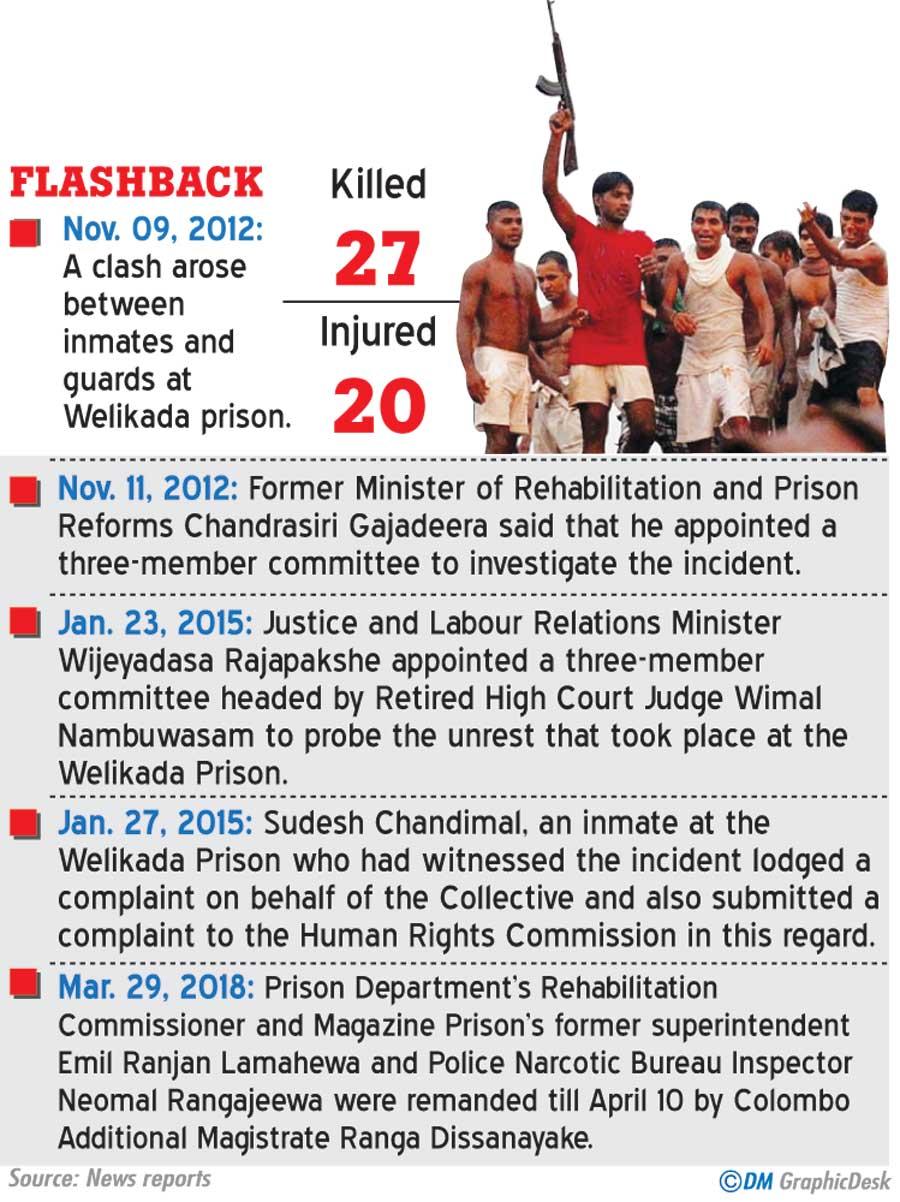02 Feb 2022 - {{hitsCtrl.values.hits}}

"However, the first accused Rangajeewa and the third accused Sampath were later acquitted as the prosecution failed to prove its case against them beyond reasonable doubt"
The failure to promptly open and carry out a criminal investigation into the 2012 Welikada riot, despite having strong evidence and testimonies of a number of witnesses and the impunity of the culprits was a topic of discussion for years.
having strong evidence and testimonies of a number of witnesses and the impunity of the culprits was a topic of discussion for years.
After nine long years since the shooting incident, which claimed 27 lives of inmates, the Colombo High Court Special Trial-at-Bar on January 12, 2022 sentenced former Welikada Magazine Prison Superintendent Emil Ranjan Lamahewage to death.
The families of the deceased inmates, together with the rights watchdog continue to claim that those responsible for the alleged extra-judicial killings include several former security officials. This allegation was proved to be not merely an allegation when in 2015 the ‘Committee of Inquiry into the Prison Incident 2012’ (CIPI) headed by Retired High Court Judge Wimal Nambuwasam and comprising retired DIG Asoka Wijetilake and retired Prisons Administrative Officer and Attorney at Law S.K.Liyanage recommended charging a number of senior security officials. Eventually, only one prison official was convicted.
Deaths in custody: Flashback
As regularly, inmates at Sri Lanka’s largest prison - Welikada Prison had just finished lunch on November 9th on a Friday in 2012. The lunch hour is usually followed by chores. But November 9 deviated from the norm. Dozens of armed security officers including the Special Task Force (STF) entered the prison for a major search operation. Soon, the inmates mobilised in numbers against the presence of the STF.
Irked by the protest of the prisoners and the uneasy situation that was being created, the officers became more brutal with their treatment of inmates. Then, the armoury was broken into by inmates. Normally, officers within a prison only move around with arms. Only on instances such as attempted jailbreak, attempted escape or when inmates use weapons against others, officers may use firearms. On November 9th, they did not hesitate to fire their arms at the protesting inmates. Soon bodies of inmates fell. By the next morning when the JMO visited the scene, 27 inmates had been shot at.
‘Did the investigation go far enough?’
The Attorney General had filed indictments against former Narcotics Bureau Chief Neomal Rangajeewa, Emil Ranjan Lamahewage and Prisons Department Intelligence Officer Indika Sampath under 33 counts, including committing murder, conspiring to commit murder after being members of an unlawful assembly. However, the first accused Rangajeewa and the third accused Sampath were later acquitted as the prosecution failed to prove its case against them beyond reasonable doubt.
Chairman of the Committee to Protect the Rights of Prisoners (CPRP), Attorney-at-Law Senaka Perera, speaking to the Daily Mirror said that the relatives of the deceased inmates and the CPRP will soon challenge the acquittal and discharging of the first accused of the case Inspector Neomal Rangajeewa.
“Due to the long delay for justice, there must have been consequences on the investigation and the evidentiary material produced before the court”
Perera said “those who had been killed were criminals who were undergoing appropriate punishment according to the rule of the law in the country. But, they did not deserve to die in that manner. Before the court case started in 2017, there were several committees and commissions appointed soon after the killings to look into this incident. It would be great if the investigations conducted by the committees during the Rajapaksa regime could be reviewed.”
He also claimed that due to the long delay for justice, there must have been consequences on the investigation and the evidentiary material produced before the court. “This incident happened in 2012. But, the CID investigation was initiated five years later. Can anyone argue that there have been no negative impacts on the findings of the investigation?”
said Perera.
Committees after committees
Eyewitnesses had given statements initially to a three-member committee appointed by the former minister of prison reforms and rehabilitation Chandrasiri Gajadeera. The committee comprised of Rtd. HC Judge Bandula Atapattu, Rtd. Dy. IGP Gunasena Thenabandu and Legal Officer of Prison Reforms Ministry Lalith Andrahennadi. The report of the first committee has not been made public. However, the report was handed over to the minister in 2013.
“At the end of their inquiry, it was made clear that several parties had wanted to put an end to the lives of a group of prisoners due to various reasons”
Then the witnesses were summoned to record statements by another commission appointed by Former Commissioner General of Prisons P.W. Kodippili. It was also handed over to the subject minister for further action.
Sri Lanka Human Rights Commission (SLHRC) also conducted a probe soon after the riot. The then Chairman of the SLHRC Prathiba Mahanamahewa said the probe report had been compiled with the findings of a team from SLHRC that was sent to the Welikada prison. That report was also handed over to the minister with recommendations on further legal action.
Then in 2015 came another report by the Committee of Inquiry into the Prison Incident 2012 (CIPI). It was headed by Retired High Court Judge Wimal Nambuwasam. Member of the CIPI Attorney at Law S. K. Liyanage, speaking to the Daily Mirror held that at the end of their inquiry, it was made clear that several parties had wanted to put an end to the lives of a group of prisoners due to various reasons.
“No one tried to level pressure on us when carrying out inquiries into the incident. Members of the victims’ families and the witnesses had confidence in our committee compared to the previous commissions that probed the case,” said Liyanage. However, all the committees that probed the incident for years including the CIPI were only able to give recommendations as they had no authorisation to prosecute the offenders.
Recommended to charge senior security officials
The prosecution of six high ranking officials previously attached to the Ministry of Defence, the State Intelligence Service, the Prisons Department and the Sixth Gajaba Regiment of the Army in relation to the Welikada Prisons incident of November 2012, had been recommended by the CIPI.
Former Superintendent of the Magazine Prison Emil Ranjan Lamahewage was also among the six officials. The CIPI in its report said the six officials should be charged under Section 162 of the Penal Code, which deals with public officers who disobey the directions of the law with the intent of causing injury to persons or the Government. Sentence for the conviction of the charge could be a term of simple imprisonment for a maximum of one year and/or a fine.
"The prosecution of six high ranking officials previously attached to the Ministry of Defence, the State Intelligence Service, the Prisons Department and the Sixth Gajaba Regiment of the Army in relation to the Welikada Prisons incident of November 2012, had been recommended by the CIPI"
The former member of the CIPI Liyanage said the committee report had been compiled with findings based on evidence from Judicial Medical Officers (JMO) who conducted the post-mortem examinations of the deceased inmates, the Government Analyst Department that conducted forensic analyses and Scenes of Crime Officers (SOCO) of the Police.
In the report, the CIPI delved into the emergency of the necessity of a major search operation, the magnitude of the search, and also the legality of it.
Furthermore, the CIPI also shed light on the outcome of the previous investigations. “The lack of a proactive investigative approach and the absence of fundamental investigative steps makes one suspect whether there were external pressures brought forth to dilute and thereby obliterate the investigation with the passage of time,” the CIPI asserted.
Lesson for prison officials?
Prison officials have a legal duty to protect prisoners in custody from any kind of harassment or assault. Officers may not use force maliciously with intent to cause harm, but they may use force in good faith efforts to keep law and order. Convener of the Committee for Protecting Rights of Prisoners (CPRP) Sudesh Nandimal Silva who is also an eyewitness to the prison riot, sharing his views regarding the recent court verdict said that the conviction of prison official Lamahewage will be a good lesson for all the prison officials on duty.
“During the riot, we saw how several prison officials blatantly violated their duties and responsibilities. So, we believe this verdict will be a good lesson for all the prison officials. We respect the court order, sentencing former prison commissioner Emil Ranjan. For so many years, survivors and victims’ family members were waiting for justice. We are glad to see at least this progress of the case,” said Nandimal.

08 Jan 2025 2 hours ago
08 Jan 2025 3 hours ago
08 Jan 2025 3 hours ago
08 Jan 2025 3 hours ago
08 Jan 2025 4 hours ago